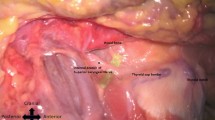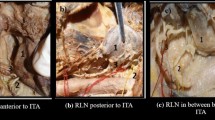Abstract
Purpose
The aim of this study was to investigate the surgical and topographical anatomy of the internal branch of the superior laryngeal nerve (ibSLN) in laryngectomy patients.
Methods
Patients aged 36–90 years old who underwent a total laryngectomy operation with a diagnosis of laryngeal carcinoma participated in the study. Fifteen patients who underwent a total laryngectomy operation between June 2015 and November 2016 were included in the study. A total of 29 superior laryngeal nerves (SLN) of 15 patients were studied. The position of the nerve was photographed before the thyrohyoid membrane (THM) was passed during dissection. The relationship and course of the ibSLN with respect to the superior laryngeal artery (SLA) were observed. The distance to adjacent formations and branching variants were examined along the course of the nerve.
Results
Of the total 29 ibSLN, 17 were divided into three branches and 12 into two branches. In all cases except for one, the ibSLN course after piercing the THM was determined. The ibSLN penetrated the THM at a mean of 12.0 ± 2.61 mm (6–16 mm) from the superior border of the thyroid cartilage. The ibSLN penetrated the THM with a mean distance of 9.34 ± 1.65 (6–12) mm from the inferior border of the hyoid bone.
Conclusion
Our study demonstrated the surgical and topographical features of the ibSLN with respect to the THM, and provided a more precise knowledge of its anatomy in laryngectomy patients. It thus may help head and neck surgeons identify this nerve.



Similar content being viewed by others
References
Sanders I, Mu L (1998) Anatomy of the human internal superior laryngeal nerve. Anat Rec 252:646–656
Paraskevas GK, Raikos A, Ionnidis O, Brand-Saberi B (2012) Topographic anatomy of the internal laryngeal nerve: surgical considertions. Head Neck 4:534–539
Kiray A, Naderi S, Ergur I, Korman E (2006) Surgical anatomy of the internal branch of the superior laryngeal nerve. Eur Spine Surg 15:1320–1325
Monfared A, Kim D, Jaikumar S, Gorti G, Kam A (2001) Microsurgical anatomy of the superior and recurrent laryngeal nerves. Neurosurgery 49:925–932
Pascual-Font A, Cubillos L, Vázquez T, McHanwell S, Sañudo JR, Maranillo E (2016) Are the interarytenoid muscles supplied by branches of both the recurrent and superior laryngeal nerves? Laryngoscope 126:1117–1122
Rueger RS (1972) The superior laryngeal nerve and the interaritenoid muscle in humans: an anatomical study. Laryngoscope 82:2008–2031
McVay CB (1984) Anson and McVay sugical anatomy, 6th edn. WB Saunders, Philadelphia, pp 267–269
Williams PL, Warnick R, Dyson M (1999) Grays anatomy, Churchill livingstone, edinburg, london, melbourne, thirthy seventh edition 734:1116-1258
Stephens RE, Wendel KH, Addington WR (1999) Anatomy of the internal branch of the superior laryngeal nerve. Clin Anat 12:79–83
Uludag M, Aygun N, Kartal K, Besler E, Isgor A (2016) Is intraoperative neural monitoring necessary for exploration of the superior laryngeal nerve? Surgery 161:1129–1138
AbuRahma AF, Choueri MA (2000) Cranial and cervical nerve injuries after repeat carotid endarteryectomy. J Vasc Surg 32:649–654
Kambic V, Zargi M, Radsel Z (1984) Topographic anatomy of the external branch of the superior laryngeal nerve. J Laryngol Otol 98:1121–1124
Weaver AW, Fleming SM (1978) Partial laryngectomy: analysis of associated swallowing disorders. Am J Surg 136:486–489
Rassekh CH, Driscoll BP, Seikaly H, Laccourreye O, Calhoun KH, Weinstein GS (1998) Preservation of the superior laryngeal nerve in supraglottic and supracricoid partial laryngectomy. The Laryngoscope 108:445–447
Furlan JC, Brandao LG, Ferraz AR, Rodrigues AJ (2003) Surgical anatomy of the extralaryngeal aspect of the superior laryngeal nerve. Arch Otolaryngol Head Neck Surg 129:79–82
Romanes G (1964) Cunningham’s textbook of anatomy, 10th edn. Oxford University Press, London, p 707
Rosse C, Gaddum RP (1997) Hollinshead’s textbook of anatomy, 5th edn. Lippincott-Raven, Philadelphia, p 850
Tillman B (2005) Atlas der Anatomie des Menschen, vol 2. Springer, Berlin, p 174
Moore K, Dalley A (1999) Clinically oriented anatomy, 4th edn. Lippincott, Williams, Philadelphia, p 1047
Basmajian JV (1971) Grant’s method of anatomy. Williams & Wilkins, Baltimore, p 634
Ziegelman EF (1933) Laryngeal nerves: surgical importance in relation to the thyroid arteryies, thyoid gland and larynx. Arch Otolaryngol 18:793–808
Bouchet A, Cuilleret J (1991) Anatomie topographique, descriptive et fonctionnelle, 2nd edn. Simep, Paris, p 59
Funding
No financial disclosures.
Author information
Authors and Affiliations
Contributions
EMG: protocol development, data collection, data analysis, and manuscript writing. KK: protocol development, data analysis, manuscript editing. MG: protocol development, data collection and management. HE: data collection, manuscript editing, MÖK: data collection and management.
Corresponding author
Ethics declarations
Conflict of interest
The authors declare that they have no conflict of interest.
Ethical approval
All procedures performed in studies involving human participants were in accordance with the ethical standards of national research committee and with the 1964 Helsinki Declaration and its later amendments or comparable ethical standards. The research protocol was submitted to and approved by the Sakarya University Ethics Committee. (16214662/050.01.04/13).
Informed consent
Informed consent was obtained from all individual participants included in the study.
Additional information
Publisher's Note
Springer Nature remains neutral with regard to jurisdictional claims in published maps and institutional affiliations.
Rights and permissions
About this article
Cite this article
Güven, E.M., Karacan, K., Güven, M. et al. Topographic anatomy of the ınternal branch of the superior laryngeal nerve. Eur Arch Otorhinolaryngol 278, 727–731 (2021). https://doi.org/10.1007/s00405-020-06395-9
Received:
Accepted:
Published:
Issue Date:
DOI: https://doi.org/10.1007/s00405-020-06395-9




